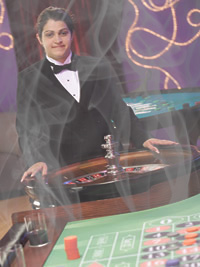Secondhand Smoke and Casino Dealers
Posted on by Simply working in a casino does not mean dealers must gamble with their health. There is nothing lucky about developing a respiratory illness, lung cancer, or heart disease—especially if you are a healthy nonsmoker. Results of new research conducted by the National Institute for Occupational Safety and Health (NIOSH) on secondhand smoke—the exposure of non-smokers to tobacco smoke—confirm that dealers at the casinos investigated were exposed to secondhand smoke. Secondhand smoke, also called environmental tobacco smoke, is a combination of smoke given off by the burning end of a tobacco product and the smoke exhaled by the smoker. Secondhand smoke is made up of approximately 4,000 chemicals, of which about 40 are known to cause cancers.
Simply working in a casino does not mean dealers must gamble with their health. There is nothing lucky about developing a respiratory illness, lung cancer, or heart disease—especially if you are a healthy nonsmoker. Results of new research conducted by the National Institute for Occupational Safety and Health (NIOSH) on secondhand smoke—the exposure of non-smokers to tobacco smoke—confirm that dealers at the casinos investigated were exposed to secondhand smoke. Secondhand smoke, also called environmental tobacco smoke, is a combination of smoke given off by the burning end of a tobacco product and the smoke exhaled by the smoker. Secondhand smoke is made up of approximately 4,000 chemicals, of which about 40 are known to cause cancers.
Longstanding NIOSH policy, consistent with and based on the U.S. Surgeon General’s position on secondhand smoke, recommends that workers should not be involuntarily exposed to tobacco smoke. Any exposure to secondhand smoke increases the risk of lung cancer, other respiratory diseases, and heart disease. Studies have shown that even low levels of secondhand smoke exposure can be harmful. The only way to fully protect nonsmokers from secondhand smoke exposure is to completely eliminate smoking in indoor spaces.
The NIOSH investigation was conducted in response to requests for an evaluation of secondhand smoke from dealers at Bally’s, Paris, and Caesars Palace casinos in Las Vegas, Nevada. NIOSH investigators conducted onsite health hazard evaluations to measure casino dealers’ exposure to secondhand smoke and to determine whether they reported related health symptoms. Employees were selected to participate in the study if they reported that they did not use any tobacco products, did not live with someone who smokes inside their home, or were not exposed to secondhand smoke in any setting other than their job at the casino. For comparison, a group of administrative and engineering staff who were not exposed to secondhand smoke at their casino job were included in the study.
NIOSH collected urine samples before and after the workers’ shifts to determine the levels of two secondhand smoke components, cotinine and NNAL (a cigarette carcinogen) in their urine. Casino dealers were found to have increasing levels of NNAL in their urine over an 8-hour work shift showing that the cigarette smoke and a carcinogen are being taken up into their bodies. NIOSH also conducted air sampling which found that components of secondhand smoke were present in the air of the three casinos. Casino dealers had more respiratory symptoms than the administrative and engineering employees, but differences were not statistically significant.
NIOSH recommended that:
- The casinos should institute casino-wide no smoking policies to eliminate exposure to secondhand smoke and develop smoking cessation programs for casino employees who smoke.
- A physician should evaluate employees with respiratory symptoms related to workplace exposures.
- The casinos should form a health and safety committee that includes employee and management representatives to address workplace health and safety concerns.
- The casinos should also eliminate smoking near building entrances and air intakes to prevent tobacco smoke from entering the work environment. Any modifications of the ventilation systems should be done in adherence with current guidelines.
In addition to scientifically confirming secondhand smoke exposure among the casino dealers, the results of this research also provide additional support for the use of NNAL as a marker of secondhand smoke exposure and will aid other researchers in future studies.
NIOSH would like to hear from you. If your workplace has gone smoke-free, please tell us about the transition. Were there specific steps taken that seemed to make the transition to a smoke-free environment easier?
The complete reports of the casino health hazard evaluations can be found at http://www.cdc.gov/niosh/hhe/reports/pdfs/2005-0201-3080.pdf ![]() . More information on the Health Hazard Evaluation (HHE) Program is available on the HHE topic page. Information on the health effects of second hand smoke can be obtained from the CDC Office on Smoking and Health and the U.S. Surgeon General’s Report on the Health Consequences of Involuntary Exposure to Tobacco Smoke.
. More information on the Health Hazard Evaluation (HHE) Program is available on the HHE topic page. Information on the health effects of second hand smoke can be obtained from the CDC Office on Smoking and Health and the U.S. Surgeon General’s Report on the Health Consequences of Involuntary Exposure to Tobacco Smoke.
Lieutenant Commander West of the United States Public Health Service is an epidemiologist assigned to NIOSH in the Division of Surveillance Hazard Evaluations and Field Studies.
Posted on by

